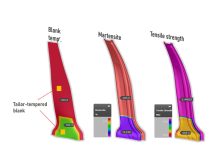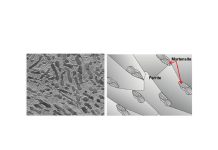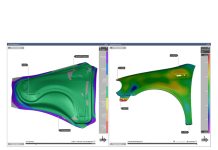As already discussed in Sheet metal plasticity visualized (part one) there are four main components needed to model the plastic deformation of sheet metals: yield function, hardening model, flow rule, and failure model. We have expanded our discussion of the Yield Function in a previous post; we shall now discuss the hardening models and flow rules, which enable modeling of how materials change in strength, or stress, once plastic deformation has begun or is initiated.
These links show part one, two and four of this series.
Hardening
There are mainly two kinds of industrially relevant hardening models: isotropic and kinematic hardening. In the case of isotropic hardening, the yield locus changes its size in the stress space as shown below for a uniaxial tension test in rolling direction. The expansion (or contraction) of the yield locus is expressed by the flow curve definition. As the material deforms, the hardening level on the flow curve moves forward with the accumulated plastic strains, and as a result the yield locus expands isotropically in all directions.

Isotropic expansion of the yield locus as a function of hardening, here for uniaxial tension test in rolling direction
Flow curves can be defined as a function of plastic strain, plastic strain rate, and temperature. In this case, the input can be visualized as follows:

Input of flow curves as a function of plastic strain, strain rate, and temperature
In most cases, flow curves are determined using uniaxial tension tests. In sheet metal forming, higher stress and strain levels are encountered than are typically achievable in a uniaxial tension test. To describe this potentially higher range of stresses and strains, extrapolation is required. For this reason, flow curves obtained through testing are extended with mathematical models like Ludwik, Swift, Hockett-Sherby, etc. These models fit empirical data to a curve that is then extrapolated to the higher strains likely to occur during sheet metal forming. Similarly, strain rate dependency can also be approximated by exponential equations.
One drawback of the isotropic hardening models is that they cannot be used to model the Bauschinger effect (1881). The Bauschinger effect shows itself as changes in the plastic behavior of the materials under load reversal (generally speaking, load direction changes) and isotropic models are blind to load reversals; the same stress level is predicted for tension and compression. This behavior can again be analyzed with the help of the yield function as shown below.
The figure shows a uniaxial tension-compression test in transverse direction (90°). In the case of isotropic hardening, the first yield stress in compression equals the last yield stress in tension. However, in the case of kinematic hardening, the yield locus moves in the direction of applied stresses, instead of expanding. Hence, needed stresses decrease in compression after load reversal.

Isotropic vs. kinematic hardening
The yield condition “decides” if material flows plastically but it does not define the direction of the plastic flow or, in other words, the strain components. For this, a flow rule is needed.
Flow rule
For the metal forming problems, an associated flow rule is utilized, namely the Levy-Mises flow rule, whereby the plastic strain increments remain always normal to the yield surface. Therefore, sometimes the term “normality rule” is used to refer to this fact. Flow rule does not give the absolute values of the plastic strain increments directly. Rather, it defines the relative size of the plastic strain components. Again, this behavior can be analyzed graphically with the help of the yield loci as shown in the following figure.

Normality rule presented at three deformation states; note illustrated behavior is anisotropic in sheet plane
The figure shows three loading states: uniaxial tension (UT), plane strain tension (PS) and equibiaxial tension (BT) on an isotropic yield locus (von Mises). The tangents on these points are presented on the right-hand side together with the normal directions. As mentioned before, the normal directions correspond to the strain increments.
In this isotropic example, for the BT-point the strain components have the same positive value in 0° and 90° as shown by the red dashed vectors. For PS-point, we can only see the strain component in 0°. There is no material flow in transverse direction. The third strain component can be calculated from volume constancy. In the UT-point, the strain component in loading direction (0°) is in positive direction and strain in transverse direction is in negative direction with the half value. This means that the isotropic tensile specimen gets longer with a strain value of 2ε, gets narrower with a strain of –ε, and gets thinner with a strain value of –ε, due to volume constancy.

Different stress states identified on a yield locus
The tangents at specific locations, or slope, of the curve at the yield locus play an important role in determining the flow direction of the sheet material. Subtle differences in the shape of the yield loci utilized during simulation will deliver visibly different results in the predicted behavior of the sheet.
Challenges

The same material parameters described using different Yield Criteria (Hill48 blue, Hill90 yellow, BBC2000 black)
The challenges regarding the prediction of flow behavior of sheet metals can be categorized in three groups:
- Material characterization: In order to increase the accuracy of the simulations, more flexible material models are used. Flexibility requires additional material parameters and more characterization tests. Testing and evaluation methods used to obtain material parameters are not standardized thoroughly, as in the case of a uniaxial tension test. Additionally, during early engineering, material properties are often limited to the minimum values for a limited set of characteristics.
- Assumption validity: Presented concepts should be selected carefully to model the sheet metals accurately. Some models are only suitable for a particular class of materials. For instance, a hardening curve derived using a Ludwik hardening model can overestimate the yield stresses for advanced high-strength steels, but the parameters for deriving a more predictive Hockett-Sherby model are not commonly available. Using an improper exponent in Barlat yield functions would change the material behavior, especially around biaxial tension and plane strain tension regions. Hill´48 model will also lead to inaccuracies around the biaxial tension region for most of the aluminum alloys.
- Press hardening: In hot stamping with quenching, the temperature is just one additional parameter, but it increases the characterization matrix enormously. Accurate determination of strain rate and temperature-dependent flow curves and temperature-dependent yield functions demands complex test setups and equipment. Some of these tests are not standardized at all.
Future trends
Academic research focuses currently on following points:
- Development of new and more flexible yield functions
- Specialized yield functions for magnesium and titanium alloys
- Development of distortional hardening models whereby the yield locus can also change in shape during deformation
- Crystal plasticity models and prediction that recognize grain orientations and crystal structures
- Robust characterization methods for hot sheet metal forming applications
From time to time we will return to these topics and expand on any advnaces and innovations in further defining these “known unknowns.”
See the final part of this series here.














Oh wow, it seems like there’s plenty of math work involved in fabricating metal. This is interesting to know about and one for me to share with my son. He’s been thinking about going to his uncle’s warehouse to do some laser cutting work.
[…] speed would seem to not influence the simulation of the material deformation, especially when using hardening criteria with no strain rate sensitivity and a single friction coefficient […]